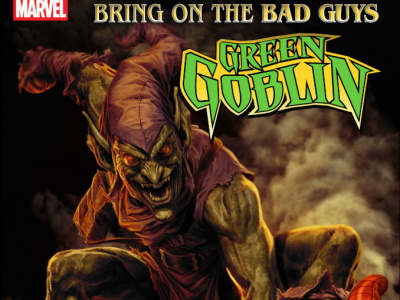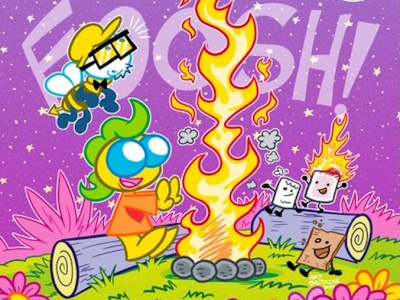
We caught up with DC Comics CEO and Publisher Paul Levitz recently for a wide-ranging interview in which we talked about the transition from the “homespun” period of the business, price increases on comics, and digital comics; content decisions in DC’s collaboration with Teshkeel and in transmedia uses of its characters (a la Batman: The Brave and The Bold); and the state of the market and the rapidly changing graphic novel business.
Are there other elements that we’re transitioning away from?
You’re transitioning away from, for lack of a better term, the homespun period of the business. When you had a very small section of graphic novels in the comic shop it was very easy for the proprietor to bet on anything that happened to be in the catalog. It doesn’t matter whether I know anything about the writer, or the artist, you got a good little blurb. When you go to a world in which the large publishers are sending you out a galley version of the graphic novel six months in advance, and are announcing on the back cover the five-step marketing program that they’re doing for it, it’s a lot harder for the little guy who’s launching it from home to do it. Is there still room for a Cartoon Books to do Bone? Sure. But Bone succeeded because it was the combination of really brilliant creativity by Jeff, and a very well-run small business by Jeff and Vijaya. We know there have been an awful lot of projects that have managed to survive on adequate creativity and a barely functioning small business. I think that’s going to be harder and harder to pull off and we’ll lose something as a result of that. That’s part of what gave the fertility to comics and the adventuresome creative feel that we’ve had in the last few years.
There is that impact is from the book channel. But isn’t part of it also Diamond being more rigorous in how they bring in new material?
I think it all works together. Diamond becomes pressured to deal with the economics more realistically if there are more graphic novels to be put through, and the ones that are working require more inventory to be carried and more attention to be paid to them. The retailers on both the book store and the comic shop side, when they have a full shelf of stuff and there’s too much for anyone to carry, have to make choices. Mercifully they will make different choices, and one of the blessings of the comic shop environment is that because there’s no one, two, or three dominant retailers you have much more ability for individual retailers to become the passionate patron of the particular project and build it up. It becomes a greater form of competition. I think there’s a more serious effort behind a lot of the old OGNs to use the new tools.
Is there an impact to the periodical format that’s a downside to the growth of graphic novels?
I don’t think so. I think it’s the downside for periodicals that don’t take advantage of the periodical form. There will be a very healthy business in the periodicals that have the coolness of the instant, whether that’s a Wednesday Comics project, or a Blackest Night project, or things from other publishers (I don’t mean to not use those as reference points, I’m just more comfortable with our own), but things where getting it this week matters. That’s meaningful for the periodical side of the business and to keep it healthy. I think when you have a periodical business that’s nothing more than a serialization of a novel, that’s going to be more challenging.
On the periodical side there’s been a lot of kvetching about the $3.99 price point. What’s your feeling about the value proposition of a $3.99 periodical comic with 24 story pages?
I don’t see that $3.99 per se is a barrier price. I think there’s a lot of question out there about what the value is. We’ve gotten a very good response to the books where we added page count and added a second feature and moved it up to $3.99. Detective Comics just switched to that recently…
Forty pagers?
Forty pagers, with 30 or 32 pages of creative. We’ve gotten a pretty good response to books where the key editorial is still probably twenty-four pages but there’s a bunch of perceived-to-be useful and valuable additional editorial material in it. We don’t seem to get much barrier to the $3.99 on things like the game books, when we’re selling them to audiences that are at least in part not comic shop devotees and we’re putting in a little extra production value.
You’re talking about the Blizzard books?
The Blizzard books, and Prototype and the other videogame titles out of Wildstorm. We’re putting in some board covers and things like that. The place where the loudest bitching about $3.99 is when it’s exactly what you were selling for $2.99 two seconds ago but you’re charging a buck extra. We haven’t done much of that, maybe not any of it (I didn’t check my stats to be able to say “not any” with a straight face). Some of our competitors have gotten beaten up more energetically as a result of doing that more.
It’s a tough economy. People are concerned about price. It’s not a very inflationary time so a price increase without added value stands out more. I don’t think it’s a great time to be moving a lot of titles through a higher price point without delivering a value that the reader finds exciting.
There’s been a lot of movement on the digital comics front, especially in the last six months, specifically in comics delivered as iPhone apps. DC has been doing some motion comics, but not really the straight digital delivery of comics. Why is DC holding back on that?
We haven’t found an enormous body of evidence that says it’s working for anybody yet. It’s very clear that there’s an opportunity there long run technically. The stuff can be delivered that way and it’s easy to reach a potentially wider audience. It’s not yet clear whether people want to buy it in any real numbers.
Pushing back on that a little, IDW said they sold more digital copies of their Star Trek Countdown comics than they did print copies. That seems like there is an audience finding the digital form.
I know their numbers. It’s not anything that makes me sit here salivating. Is it good as a plus business? Sure. But it’s not a game changer, or certainly wouldn’t be a game changer for us. Will that be different any minute now? Maybe. All of this stuff technologically is coming online literally app by app, minute by minute. We’re looking at everything that comes out there. We’re looking at what we would do ourselves. We’ve had long conversations about what titles we think would be the most meaningful to put out that way and which of the various business models is worth pursuing most quickly. Again I think it’s a time of transition. Will there be a place in the market for some delivery like that? Certainly. It’s not clear yet what it’s going to be.
We’re in a good position because we have one of the great libraries and the high recognition value properties. So whenever the delivery method works, this week, next week, a year from now, three years from now, we will have valuable content to sell that way if there are people in the process of buying it that way.
Do we have to be a first mover? I’m not convinced we have to. I’m not sure this is an area where there’s a giant first mover advantage. You’re not going to make the brand Batman more powerful or less powerful over whether or not it’s delivered in an iPhone app for comics. The brand is universally known, enormously powerful in the marketplace.
Will somebody want to get Frank’s Dark Knight Returns that way someday? Sure. And there will come a point in which we sell it to them that way. I don’t think we have to be the first title offered for that to be a good opportunity.
For Part 3 of this interview, click here.







